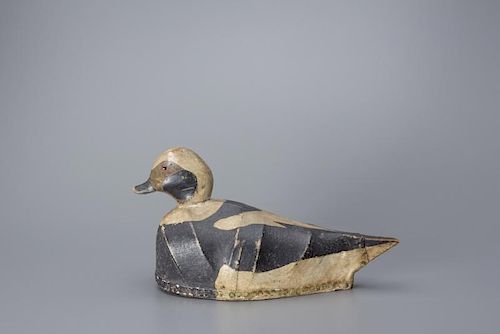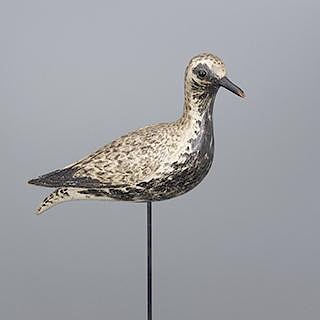Canvas-Covered Long-Tailed Duck Lothrop Turner Holmes (1824-1899)
About Seller
20 Winter Street
Pembroke, MA 02359
United States
Founded in 2005, Copley Fine Art Auctions is a boutique auction house specializing in antique decoys and American, sporting, and wildlife paintings. Over the course of the last two decades, the firm has set auction records for not only individual decoy makers, but also entire carving regions. Copley...Read more
Two ways to bid:
- Leave a max absentee bid and the platform will bid on your behalf up to your maximum bid during the live auction.
- Bid live during the auction and your bids will be submitted real-time to the auctioneer.
Bid Increments
| Price | Bid Increment |
|---|---|
| $0 | $50 |
| $1,000 | $100 |
| $2,500 | $250 |
| $5,000 | $500 |
| $10,000 | $1,000 |
| $25,000 | $2,500 |
| $50,000 | $5,000 |
About Auction
Jul 27, 2017 - Jul 28, 2017
Copley Fine Art Auctions cinnie@copleyart.com
- Lot Description
Canvas-Covered Long-Tailed Duck
Lothrop Turner Holmes (1824-1899)
Kingston, MA, c. 1855
13 in. long
Those acquainted with the work of Lothrop Holmes come to expect a certain level of craftsmanship and attention to detail that is scarcely found elsewhere, and this long tail is no exception.
The head carving is done with an efficiency and sophistication that captures the nuances of the species. Some of its features include well-developed cheeks that rise to subtle eye grooves which meet at a sharp forehead that ascends to a broadened crown. The slightly upswept bill, with subtle nail carving, gives this bird one of the most pleasing attitudes of the entire rig. The body is constructed with canvas, fastened by copper tacks stretched over bent wooden slats. Dr. George Ross Starr summed up this bird’s rigmate saying, “Simple, light and above all beautiful - that was a Loth Holmes decoy.”Gigi Hopkins, in Massachusetts Masterpieces, credits Holmes with innovating his decoy designs, “The carver also made undeniably cute, framed, canvas-covered oldsquaw – and if he was making these between the ages of 25 to 30, it dates them to the 1850s, making it fairly clear that Holmes invented this lightweight form.”Inscribed on the bottom board “LOTHROP HOLMES KINGSTON, MASS.” Adding to the accolades of this bird, a rigmate was depicted on the 1980 Massachusetts Waterfowl Stamp and print. This is an excellent example from the most celebrated rig of canvas decoys.
Original paint with gunning wear and working touch-up to tail chip.
Provenance: Dr. George Ross Starr, Jr. Collection
Donal C. O'Brien, Jr. Collection
Literature: Laurence Sheehan, "The Sporting Life," New York, NY, 1992, p. 82, exact decoy illustrated.
Paul A. Johnsgard, "The Bird Decoy: An American Art Form," Lincoln, NE, 1976, p. 67, rigmate illustrated.
George Ross Starr, Jr. M.D., "Decoys of the Atlantic Flyway," New York, NY, 1974, pp. 56-57, color plate 3, rigmate illustrated.
Massachusetts Waterfowl Stamp, 1980, rigmate illustrated.
Jeff Waingrow, "American Wildfowl Decoys," New York, NY, 1985, pp. 66-67, rigmate illustrated.
Rob Moir and Jackson Parker, "Massachusetts Waterfowl Decoys," The Magazine Antiques, September 1989, p. 524, plate XIII, rigmate illustrated.
Peter Johnson and Alf Wannenburgh, “The World of Shooting,” Lausanne, Switzerland, 1987, pp. 259-261, exact decoy partially illustrated.
Exhibited: New York, New York, “The Art of the American Decoy: Folk Sculpture from the Collection of Mr. and Mrs. Donal C. O’Brien Jr.,” Museum of American Folk Art, September 3–November 8, 1981.Condition
Condition report requests can be made via email or by telephone (info@copleyart.com or 617.536.0030). Any condition statement given is a courtesy to customers, Copley will not be held responsible for any errors or omissions. The absence of a condition statement does not imply that the lot is in perfect condition.
- Shipping Info
-
Shipping info
Copley Fine Art Auctions does not handle the shipping of any items. Shipping is the sole responsibility of the buyer. Once your payment has cleared, and we have received your authorized shipping release form items may be released for shipment. Copley Fine Art Auctions, LLC shall have no liability for any loss or damage to such items. Buyers should allow up to four weeks for shipment.PLEASE BE AWARE THAT INTERNET BIDDERS MAY NOT PICK UP THEIR ITEMS AT THE SALE SITE. ITEMS CAN BE PICKED UP BY APPOINTMENT OR SHIPPED STARTING FIVE DAYS AFTER THE CONCLUSION OF THE SALE
-
- Buyer's Premium



 EUR
EUR CAD
CAD AUD
AUD GBP
GBP MXN
MXN HKD
HKD CNY
CNY MYR
MYR SEK
SEK SGD
SGD CHF
CHF THB
THB














